

Indigenous knowledge of a changing climate. ArcticNet. Inuit adaptability to changing environmental conditions over an 11-year period in Ulukhaktok, Northwest Territories. Introduction Indigenous communities in the Arctic have been identified as being particularly sensitive to climatic changes due to a high dependence on the environment for their livelihoods (Larsen et al., 2014).
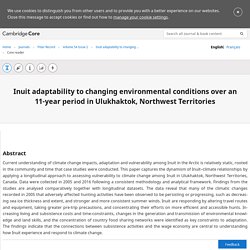
Recognition of the sensitivity of these communities to climate change has led to a broad body of scholarship focused on climate change impacts, adaptation and vulnerability (IAV). Much of this research employs the concepts of vulnerability, adaptation or resilience, and draws upon interviews with community members to identify and characterise community-relevant risks and adaptive responses (Ford & Smit, 2004). This work has provided substantial information on how Indigenous communities across the Arctic are experiencing and responding to climatic changes (e.g.
Brannlund & Axelsson, 2011; Huntington et al., 2017; McNeeley & Shulski, 2011; Nuttall, 2017; Tyler et al., 2007). Case study: Ulukhaktok, NT Fig. 1. Research approach Methods Data collection Table 1. Longitudinal datasets. Vulnerability and adaptive capacity of Inuit women to climate change: A case study from Iqaluit, Nunavut POSTER. Inuit Traditional Ecological Knowledge (TEK), Subsistence Hunting and Adaptation to Climate Change in the Canadian Arctic.
Inuit, Whaling, and Sustainability - Milton M. R. Freeman, Lyudmila Bogoslovskaya, Richard A. Caulfield, Igor I. Krupnik, Ingmar Egede. Culture and sustainable development: indigenous contributions: Journal of Global Ethics: Vol 11, No 1. Disclosure statement No potential conflict of interest was reported by the authors.

Notes on contributors Krushil Watene is Lecturer in Philosophy with Massey University. Her research includes contemporary moral and political philosophy and development studies – with a particular commitment to indigenous philosophies and development. She was previously Research Fellow with the James Henare Māori Research Centre, University of Auckland. Mandy Yap is Research Officer and Doctoral Research Scholar with the Centre for Aboriginal Economic Policy Research (CAEPR), Australian National University.
Arctic lifestyle could lead the way for sustainable future. THE lifestyle of Inuit people in Canada's Arctic regions could inspiration to the world on how best to respond to climate change, a Sunshine Coast researcher has suggested.
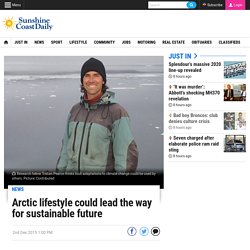
USC Sustainability Research Centre research fellow Tristan Pearce co-authored a paper on The Adaptation Challenge in the Arctic, which analysed how Inuit people who rely on subsistence hunting are adapting to climate change. Dr Pearce said that while Inuit were often considered to be highly vulnerable to the effects of climate change, the new research demonstrated that Inuit culture is remarkably adaptable to these challenges. "Inuit people have an intimate connection to and knowledge of the environment, but this knowledge is not fixed," he said.
"Instead, it's highly dynamic. Inuit views of nature. (4) Inuit Culture Arctic Biome. Using traditional knowledge, cultural values and science, Inuit are adapting to climate change in Canada's North. Sustainability & vulnerability : aboriginal arctic food security in a toxic world. Berry Plants and Berry Picking in Inuit Nunangat: Traditions in a Changing Socio-Ecological Landscape.
Data Collection During IPY, interviews were conducted by the research teams in Kugluktuk (S.

Desrosiers and J. Gérin-Lajoie), Baker Lake (J. Gérin-Lajoie and C. Spiech), Pond Inlet (J. The core interviews were conducted between 2007 and 2011 with all necessary permits. In Arviat, interviews were conducted by local youth with the assistance of N. Inuit - New World Encyclopedia. Inuit (plural: the singular, Inuk, means "man" or "person") is a general term for a group of culturally similar indigenous peoples inhabiting the Arctic regions of Alaska, Greenland, and Canada, and Siberia.

There has been a remarkable homogeneity in the culture throughout these areas, which have traditionally relied on fish, marine mammals, and land animals for food, pets, transport, heat, light, clothing, tools, and shelter. The Inuit language is grouped under Eskimo-Aleut languages. National Representational Organization for Inuit in Canada. Country Food (Inuit Food) in Canada. Sustainability Concepts in Indigenous and Non-Indigenous Cultures. The Canadian Encyclopedia. Inuit Encyclopedia of Cultures & Daily Life. Inuit Societal Values. From its start in 1999, our government has been guided by Inuit societal values.
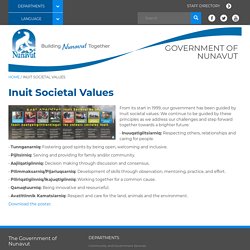
We continue to be guided by these principles as we address our challenges and step forward together towards a brighter future: • Inuuqatigiitsiarniq: Respecting others, relationships and caring for people. • Tunnganarniq: Fostering good spirits by being open, welcoming and inclusive. • Pijitsirniq: Serving and providing for family and/or community. • Aajiiqatigiinniq: Decision making through discussion and consensus. • Pilimmaksarniq/Pijariuqsarniq: Development of skills through observation, mentoring, practice, and effort. • Piliriqatigiinniq/Ikajuqtigiinniq: Working together for a common cause. • Qanuqtuurniq: Being innovative and resourceful. First Nations, First Thoughts: The Impact of Indigenous Thought in Canada. A Comparative Look at Inuit Lifestyle. Transportation For generations the Inuit people of Nunavut lived a traditional life in the Arctic, moving from one place to another with the seasons, to hunt caribou, muskox and seal, or fish for char and whitefish.
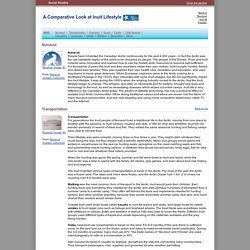
Inuit did not wander aimlessly in search of meat and fish. They visited the same seasonal hunting and fishing camps each year to harvest food. Their lifestyle was semi-nomadic moving three or four times a year. They might catch whatever they could along the way, but they always had a specific destination. Inuit Culture. (4) Tuktu- 1- His Nice New Clothes (making clothes from animal skins) Inuit Youth in a Changing World. The rapid social changes that have taken place in the Canadian Arctic over the past 20 to 30 years have created a host of challenges and dilemmas for young Inuit.

The members of this younger generation are coming of age during a period of fundamental change in northern society. A previously nomadic population has been concentrated into centralized settlements and towns, resulting in population growth and increased economic security. More Inuit are exposed to southern values through travel, schooling, television and radio. Because of all these changes, young people have grown not only more autonomous but have been able to delay the acceptance of adult roles and responsibilities. Towards Information Self-Sufficiency: The Nunavik Inuit gather information on ecology and land use.
In November 1975, the Inuit of Nunavik (northern Quebec, Canada) signed the James Bay and Northern Quebec Agreement, a document that would bring significant change to all aspects of the cultural, economic and political life of Nunavik.
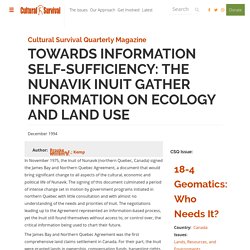
The signing of this document culminated a period of intense change set in motion by government programs initiated in northern Quebec with little consultation and with almost no understanding of the needs and priorities of Inuit. The negotiations leading up to the Agreement represented an information-based process, yet the Inuit still found themselves without access to, or control over, the critical information being used to chart their future.
The James Bay and Northern Quebec Agreement was the first comprehensive land claims settlement in Canada. Principles of Sustainability. Only recently, have debates about global climate change taken into account human responsive capacity or adaptive capacity.
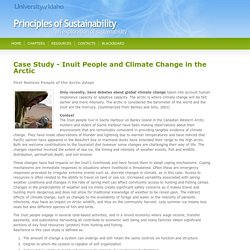
The arctic is where climate change will be felt earlier and more intensely. The arctic is considered the barometer of the world and the Inuit are the mercury. Ice worlds [videorecording] / produce... Date: 2002 By: Quinn, Max.; Stevenson, Dougal.; Natural History New Zealand Ltd.; Pangaea Entertainment (Firm) Identifier: ISBN 0958230315 Life at the edge: explores life in the polar regions. 'Sea, ice, snow ... it’s all changing': Inuit struggle with warming world. Martin Shiwak is navigating his snowmobile along the frozen shoreline when his eight-year-old son Dane, who is riding on the back, points at a wall of stunted spruce trees.
Shiwak cuts the engine, hops off the machine and quietly pulls out a .12 gauge shotgun. He hands the weapon to Dane, and the pair crouch behind their snowmobile. Dane fires two quick shots. Two white partridges, almost invisible in the tree line, drop dead. Dane runs to retrieve the birds, warming his hands against their bodies to ward off the chill from the cold wind whipping in from the North Atlantic Ocean.
Shiwak is an Inuit trapper and hunter who grew up relying on the wild bounty of Labrador. But he’s running out of time. The sea surrounding coastal Labrador is warming at an unprecedented rate, according to data from Canada’s Department of Fisheries and Oceans. “If you look at the rate of warming from the late 1980s to 2015, this is one of the fastest warming places in the world. Some changes are more subtle. Inuit Observations on Climate Change - Summary Version. Weather, Climate Change, and Inuit Communities in the Western Canadian Arctic - HISTORICALCLIMATOLOGY.COM.